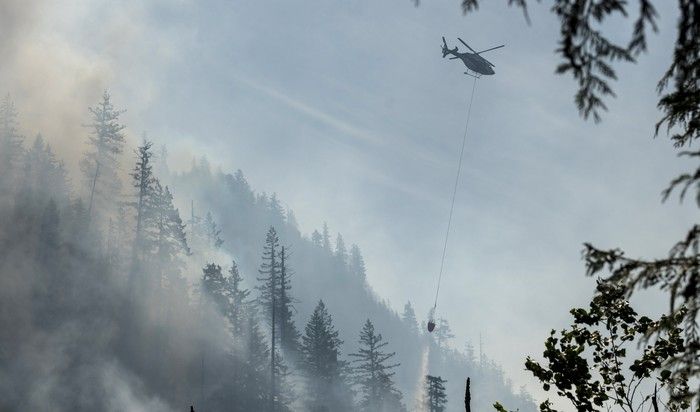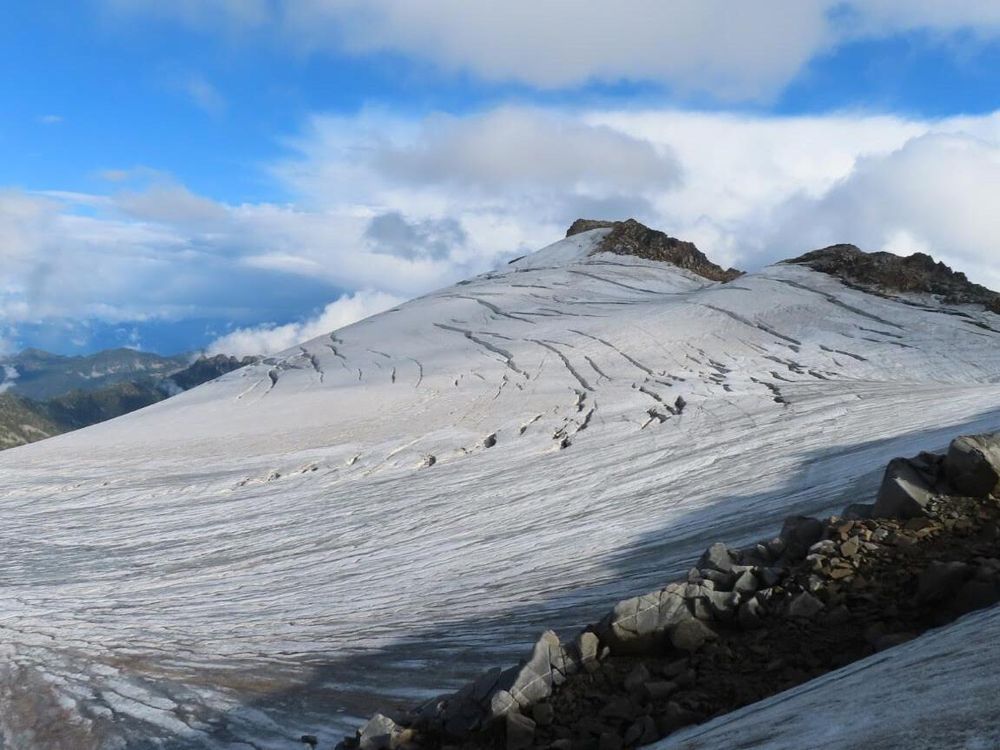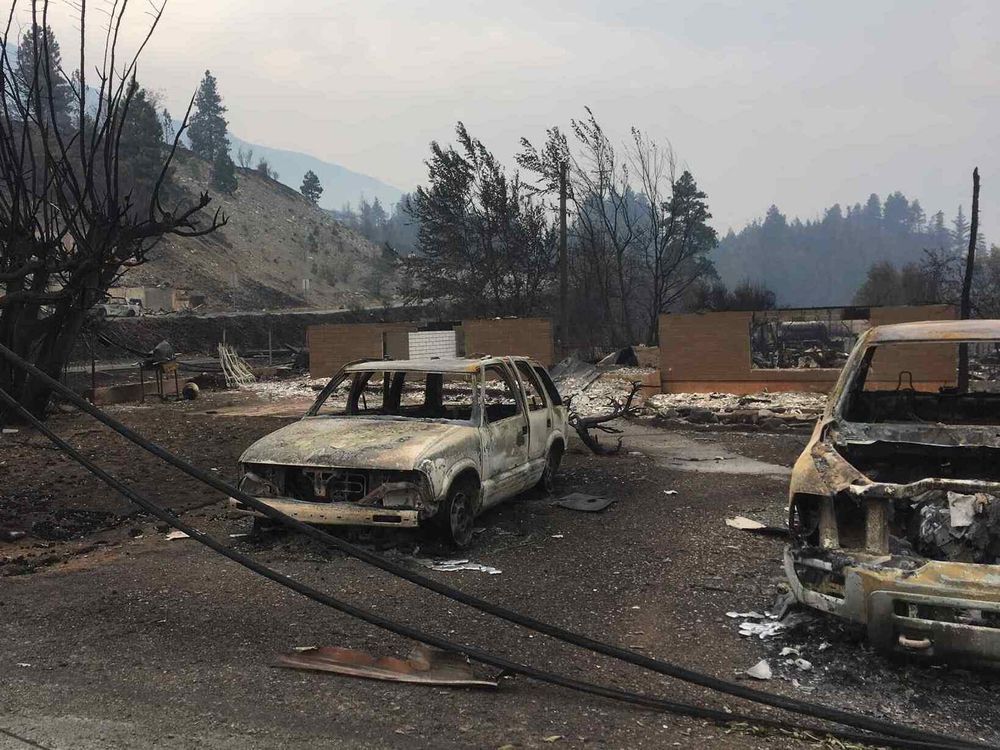
Here’s the latest news concerning climate change and biodiversity loss in B.C. and around the world, from the steps leaders are taking to address the problems, to all the up-to-date science.
Check back every Saturday for more climate and environmental news or sign up for our Climate Connected newsletter HERE.
In climate news this week:
• Western Canada glaciers melting twice as fast as in previous decade, research says
• TransLink to add 102 electric buses with Metro Vancouver approval of $479 million funding
• UBC report calls for bolder action to combat deadly extreme heat
• Experts say climate change could start the next financial crisis
• Extreme heat causes more than 100 to fall ill at grad ceremony in U.S.
Human activities like burning fossil fuels and farming livestock are the main drivers of climate change, according to the UN’s intergovernmental panel on climate change. This causes heat-trapping greenhouse gas levels in Earth’s atmosphere, increasing the planet’s surface temperature.
The panel, which is made up of scientists from around the world, including researchers from B.C., has warned for decades that wildfires and severe weather, such as the province’s deadly heat dome and catastrophic flooding in 2021, would become more frequent and intense because of the climate emergency. It has issued a code red for humanity and warns the window to limit warming to 1.5 C above pre-industrial times is closing.
According to NASA climate scientists, human activities have raised the atmosphere’s carbon dioxide content by 50 per cent in less than 200 years, and “there is unequivocal evidence that Earth is warming at an unprecedented rate.”
And it continues to rise. As of June 5, carbon dioxide in the atmosphere has risen to 430.51 parts per million, up from 429.64 ppm last month and 427.09 ppm in March, according to NOAA data measured at the Mauna Loa Observatory, a global atmosphere monitoring lab in Hawaii. The NOAA notes there has been a steady rise in CO2 from under 320 ppm in 1960.

Climate change quick facts:
• The Earth is now about 1.3 C warmer than it was in the 1800s.
• 2024 was hottest year on record globally, beating the record in 2023.
• The global average temperature in 2023 reached 1.48 C higher than the pre-industrial average, according to the EU’s Copernicus Climate Change Service. In 2024, it breached the 1.5 C threshold at 1.55 C.
• The past 10 years (2015-2024) are the 10 warmest on record.
• Human activities have raised atmospheric concentrations of CO2 by nearly 49 per cent above pre-industrial levels starting in 1850.
• The world is not on track to meet the Paris Agreement target to keep global temperature from exceeding 1.5 C above pre-industrial levels, the upper limit to avoid the worst fallout from climate change including sea level rise, and more intense drought, heat waves and wildfires.
• On the current path of carbon dioxide emissions, the temperature could increase by as much 3.6 C this century, according to the IPCC.
• In June 2025, global concentrations of carbon dioxide exceeded 430 parts per million, a record high.
• Emissions must drop 7.6 per cent per year from 2020 to 2030 to keep temperatures from exceeding 1.5 C and 2.7 per cent per year to stay below 2 C.
• There is global scientific consensus that the climate is warming and that humans are the cause.
(Sources: United Nations IPCC, World Meteorological Organization, UNEP, NASA, climatedata.ca)
Latest News

Western Canada glaciers melting twice as fast as in previous decade, research says
Researchers say some glaciers in Western Canada and the United States lost 12 per cent of their mass from 2021 to 2024, doubling melt rates compared to the previous decade in a continuation of a concerning global trend.
The research led by a University of Northern British Columbia professor, Brian Menounos, says low snow accumulation over winter, early-season heat waves, and prolonged warm and dry spells were contributing factors.
It says impurities such as ash from severe wildfire seasons have also “darkened” glaciers, causing them to absorb more heat and triggering a feedback loop that will lead to continued loss unless the ice is covered by fresh snow.
The study, published in the peer-reviewed journal Geophysical Research Letters this week, examined glaciers in Western Canada and the United States, excluding Alaska and Yukon, as well as Switzerland, where glaciers lost 13 per cent of their mass over the same period.
The research letter says glaciers in both regions lost mass twice as fast as they did between 2010 and 2020.
Menounos says climate change and its effects, including heat waves and changing snow patterns, are draining the “bank account” of fresh water that glaciers contain.
—The Canadian Press
More than 100 people at grad ceremonies fall ill due to extreme heat in U.S.: NBC report
NBC reports that two outdoor graduation ceremonies in Paterson, New Jersey, held during a dangerous heat wave ended with more than 100 people being treated and some being taken to the hospital.
The Paterson Fire Division told NBC it treated about 50 people at Hinchliffe Stadium on Monday during the first high school graduation ceremony. Nine people were taken to the hospital.
During a second ceremony later in the day, about 100 people ended up needing treatment, and seven were taken to the hospital, the NBC report said.
Temperatures climbed to near 40 C on Monday, the report said.
Experts predict climate change could start the next financial crisis
If you are over the age of 40, there is a good chance you remember where you were on September 15 2008, the day Lehman Brothers went bust. It was one of the first of many shocking moments during the last global financial crisis, a searing time of bank runs, crashes and bankruptcies when big economies tumbled into some of their deepest recessions since the Great Depression.
Stunned Lehman staff, who left the 158-year-old investment bank’s offices carrying their belongings in cardboard boxes, came to symbolize the millions who lost their jobs, homes and life savings in a disaster that destroyed trillions of dollars of wealth.
There were multiple culprits for the mayhem but, as with so many financial debacles, the property market was implicated. In 2006, the air went out of a U.S. housing bubble fuelled by supposedly safe mortgage-backed securities that had been sold around the world and included risky “subprime” home loans. As the number of mortgage defaults and foreclosures climbed, the value of these securities plunged, saddling investors with crippling losses and prompting panic in financial markets.
In the months after the crisis hit, government bailouts and sweeping reforms began to put the battered financial system back together. Today, big banks are better capitalized. Markets are better regulated and investors more protected as a result of those reforms. And yet each month now brings warnings with echoes of that strife. Fears are growing that property markets could again be roiled, this time not by risky lending practices but by rising numbers of climate-related disasters putting pressure on insurers and other critical financial institutions.
“Property values will eventually fall — just like in 2008 — sending household wealth tumbling,” said Next to Fall, a December report on climate change and insurance from the then Democrat-chaired U.S. Senate Budget Committee. “The United States could be looking at a systemic shock to the economy similar to the financial crisis of 2008 — if not greater.”
In January, the Financial Stability Board, which was set up to keep an eye on the global financial system after the 2008 crisis, said insurance was becoming more costly and scarce in disaster-prone areas and “climate shocks” could set off wider market turmoil.
—Financial Times

Switzerland’s ebbing glaciers show a new, strange phenomenon: holes reminiscent of Swiss cheese
Climate change appears to be making some of Switzerland’s vaunted glaciers look like Swiss cheese: full of holes.
Matthias Huss of the glacier monitoring group GLAMOS offered a glimpse of the Rhone Glacier, which feeds the eponymous river that flows through Switzerland and France to the Mediterranean, shared the observation with The Associated Press this month as he trekked up to the icy expanse for a first “maintenance mission” of the summer to monitor its health.
The state of Switzerland’s glaciers came into stark and dramatic view of the international community last month when a mudslide from an Alpine mountain submerged the southwestern village of Blatten. The Birch Glacier on the mountain, which had been holding back a mass of rock near the peak, gave way — sending an avalanche into the valley village below.
Experts say geological shifts and, to a lesser extent global warming, played a role.
Fortunately, the village had been largely evacuated beforehand, but Swiss authorities said a 64-year-old man had gone missing after the incident. Late Tuesday, regional Valais police said they had found and were examining human remains of a person who died in the mudslide.
—The Associated Press
TransLink to add 102 electric buses with Metro Vancouver approval of $479 million funding
TransLink announced Friday it will expand its electric fleet with another 102 buses, add electric chargers, and upgrade the Port Coquitlam transit centre.
The investments are possible with approval Friday from Metro Vancouver’s board of directors for $479 million in spending allocated from money that comes from the federal government’s community building fund.
TransLink already has 19 battery-electric powered buses on the road with 57 more on the way to help replace its diesel fleet, part of a plan to help reduce its greenhouse gas emissions.
With the latest funding, seven more battery-powered buses will roll out this year, 64 in 2026, and 31 in 2027.
“We are now set up to replace aging diesel buses with a diversified fleet that will serve our customers efficiently and sustainably,” said TransLink CEO Kevin Quinn.
TransLink already operates the second-largest fleet of 262 fully electric trolley buses in North America. They operate off of overhead cables and are different than the 178 battery-powered buses TransLink will have after this round of funding. Its fleet totals about 1,700, including 466 diesel-electric hybrids, 401 diesel buses, 299 compressed natural gas buses, and 163 gasoline-powered community shuttle buses.
—Gordon Hoekstra
UBC report calls for bolder action to combat deadly extreme heat
On the anniversary of the deadly 2021 heat dome that killed 619 people, a University of B.C. report calls for bolder action to combat deadly heat extremes and a broader approach to help the most vulnerable.
Recommendations from the report — Too Hot to Think Small: The Case for a Right to Cool in British Columbia — calls for governments to expand and improve air-conditioning-unit distribution programs, make public transit free during heat waves, improve tenancy protections for renters, and for both the B.C. and federal government to put more money into “green” social housing that includes new non-profit housing and retrofitting older housing stock.
Liz Yoon, an assistant professor in the school of kinesiology at UBC and a co-author of the report, says while there have been incremental improvements since the last heat dome, they are not enough.
Only the next heat dome will test those changes, she said. “I think we should be aiming for no deaths. And I think right now, we’re at a fewer-deaths point,” said Yoon.
The report, produced by the UBC centre for climate justice, recommends what it calls vacancy control, which ties rents to units rather than individual renters so that rents cannot be increased when people move out.
That would remove the incentive to evict people and increase housing security, which in turn reduces heat vulnerability, says the report. Renters can be afraid to push landlords for cooling when they fear losing their unit and facing higher rental costs elsewhere, renters and advocates have said.
—Gordon Hoekstra
Intensifying heat dome over parts of Eastern Canada fuelling unpredictable weather in the West
Blame the heat dome hanging over Ontario and Quebec for some of the strange weather hitting other parts of the country.
Environment Canada meteorologist Julien Pellerin says scorching temperatures over the eastern part of the continent are causing below-normal temperatures in other regions, which have led to warnings of wet snow and heavy rain in the West.
“If you have a heat dome on a sector, you can expect colder air in another sector, so that’s what the Prairies are currently experiencing,” Pellerin said on Sunday.
“It’s coming from the United States, a high-pressure system that doesn’t move quickly … so it brings intense heat and moist air over southern Ontario and southern Quebec, and it’ll settle there for the next three days.”
The dangerous temperature levels span from southwestern Ontario towards North Bay, Sudbury and Timmins, while in Quebec, the highest temperatures were expected from Montreal to Shawinigan and north up to Abitibi.
Pellerin expected Ontario and Quebec to hit their peak daytime highs on Monday and Tuesday with temperatures rising above 30 C, and the humidex making it feel more like 40 to 45 degrees, depending on the region.
—The Canadian Press
Nearly half the U.S. population sweltered in scorching heat wave
Tens of millions of Americans sweltered outside or sought air-conditioned refuge as an “extremely dangerous” heat wave blanketed the eastern United States on Tuesday with record high temperatures.
As a fierce sun reflected off the skyscrapers of New York, the normally frenetic Times Square was virtually deserted by mid-day as the mercury reached 37 C, the hottest since 2012 in the Big Apple.
By mid-afternoon Newark, N.J., hit 39.4 C, according to the National Weather Service, and Philadelphia also reached 38 C.
“Extremely dangerous heat persists across the Midwest and East Coast … affecting nearly half of the U.S. population at 161 million people,” the NWS warned in an advisory, which also urged people to limit their physical activity due to poor air quality.
—AFP

Defence budgets need to fight war and climate change, experts say
War and climate change are existential threats that need to be battled at the same time and often with the same tools, experts say. Their comments come as NATO members gather this week in The Hague to discuss boosting military budgets amid conflicts raging in Ukraine, Gaza and, most recently, Iran.
The meeting is also happening against a backdrop of rising global temperatures, which have increased the threat of more intense and frequent natural disasters, such as wildfires and floods. Catastrophes across Europe have already become so overwhelming that governments have increasingly deployed their armies for relief efforts.
Countries should identify the areas where climate and conflict overlap to use budgets more efficiently, said Julian Popov, a senior fellow at Brussels think tank Strategic Perspectives and Bulgaria’s former minister of the environment.
“We can’t tackle these crises separately because the resources are insufficient,” he said. “We have to find ways to deal with them in a combined way.”
NATO and armed forces across the world routinely recognize climate change as a security risk that will touch every aspect of defence over the long term. Water scarcity is contributing to instability in some regions, adding fuel to existing conflicts, according to the United Nations. The melting Arctic is unlocking new maritime routes, spurring a race to control the resources-rich region. Armies are vulnerable to climate change, too, with extreme weather events threatening strategic infrastructure and making military operations harder to plan.
—Bloomberg News
‘Only a matter of time’ until Ottawa faces a catastrophic heat wave
In the months before Ottawa sweated through this week’s extreme heat event, Glen Kenny was creating his own heat waves at the University of Ottawa research unit he heads.
Inside the extensive series of labs, volunteers exercised, spent time and even slept in temperatures topping 40 degrees during the day and slightly cooler at night while being closely monitored.
Kenny, a professor of physiology at the University of Ottawa and the University Research Chair in Human Environmental Physiology, has spent the past 35 years studying the impact of heat on people – including himself. Kenny is one of the world’s leading experts on the subject and heads the world’s largest research lab assessing the effects of heat stress.
Kenny’s work has helped inform policies and guidelines to protect people who work and live in the heat. It has helped reshape the understanding of human heat resiliency.
With growing numbers of extreme heat events driven by climate change, that work has taken on a new urgency.
Kenny warns that society needs to do a better job of understanding the impact of extreme heat and how to mitigate it because things are likely to get worse with potentially disastrous consequences.
—Ottawa Citizen
Forestry companies can do more to reduce wildfire risk, says B.C. report
A report by B.C.’s Forest Practices Board urges the provincial government to enlist logging companies in the effort to reduce wildfire risk across B.C.
A report following a two-year investigation found that outdated rules and unclear responsibilities are preventing forestry from becoming a powerful wildfire-defence tool.
The independent forestry watchdog agency examined forestry operations from 2019 to 2022 in wildfire risk zones where communities and forests meet in the Sea to Sky, Cariboo-Chilcotin and Peace natural resource districts, covering the Coast, Interior and northeastern regions of B.C.
“More than one million British Columbians live in interface areas with high or extreme wildfire risk,” said Keith Atkinson, the chairman of the Forest Practices Board. “Foresters are already active in these spaces. With better rules and incentives, their efforts can become part of the wildfire solution.”
B.C. forest ministry officials said it will take time to “carefully” review the final report and consider its recommendations.
The Forest Practice Board’s research shows that logging occurs at about 11 times the rate of wildfire risk reduction work in B.C.
—Gordon Hoekstra, Glenda Luymes